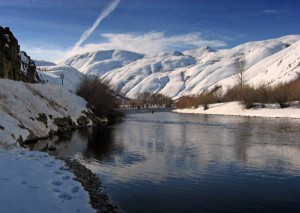Winter on the South Fork Boise. It is usually a time for the most dedicated anglers, but mostly quiet. So this website will fill some time with a few science reports that we’ll strip out over this month. We’ll call it Science February.
“The river was cut by the world’s great flood and runs over rocks from the basement of time. On some of those rocks are timeless raindrops. Under the rocks are the words, and some of the words are theirs. I am haunted by waters”
When Norman Maclean penned those words in the immortal novella A River Runs Through It, he referenced the Big Blackfoot and the Clark Fork Rivers of Montana. The world’s great flood referenced the break of the ice plug that held back Lake Missoula, draining the lake, creating the channeled scablands of eastern Washington, and depositing sediment in the Willamette Valley of Oregon. But whose “words are theirs” the words found under the rocks?
One answer might be the denizens of the river bottom. The aquatic macroinvertebrate species we commonly know as insects like may flies, caddis, stone flies. Food for trout, and tools for the trade for anglers who con the fish.
More than thirty years ago the government agencies were collaborating on the South Fork Boise River and a study was made of the effect of the changing flow levels on the SFB and its effects on aquatic insects.
This written report has sat on some shelves, lost in the past. Thanks to retired Bureau of Reclamation employee Richard Prange, a long-time leader in the Boise Valley Fly Fishers and the Ted Trueblood Chapter of Trout Unlimited, we now have unearthed the report. And with the cooperation of the staff at Idaho Fish and Game the report is now digitized and available at the IDFG digital research library (warning, a large 16.7 MB .pdf).
In a nutshell, the study measured the effects of rapid changes in flow releases from Anderson Ranch Dam. Effects of “catastrophic drift” of aquatic insects was measured as an effect of flow changes. There are measurable effects on drift, less so on overall abundance of the insects. Radio tagged fish appeared less affected. But rapid flow changes in the fall (such as to follow electricity demand) appeared to show a negative impact on whitefish reproduction.
The study was an important element supporting the measured flow regime we have today. While not perfect (e.g., flow drops at the end of irrigation season), the operating manual for Anderson Ranch Dam is more responsive than many water project facilities to the ecology of the river downstream.







